Today we’ll talk about how to correctly, and most importantly safely, take turns on a car.
1. Turn path
The safest way to go through corners is the so-called “smoothing” trajectory.
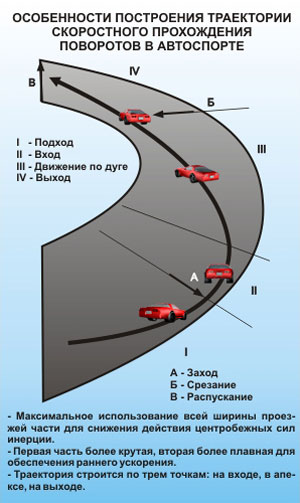
A good example of an optimal construction of the trajectory can serve as motorsports. The picture above shows a “smoothing” trajectory that can be used not only in motorsport, but also in real situations.
The peculiarity of this trajectory is that the car does not move along a constant radius: the entrance to the turn is carried out along a steep arc, and the exit is more gentle. Such a trajectory allows you to pass the turn, not only quickly, but also safely.
To build such a trajectory, the car at the beginning of the turn moves closer to the outer side of the road, then the apex passes (the point at which the car is closest to the inner edge of the road), and the exit from the turn passes again along the outer edge of the road.
When passing through any turn, it is important to identify three points:
- corner entry point
- apex
- exit point
Reset speed and braking to the point of entry into the turn. At the entry point, the steering wheel turns to the desired angle and the car begins to move in an arc, from the outer edge of the road to the inside. At the apex point, the steering wheel must begin to return to its original position, corresponding to straight wheels. At the same time, you can gradually press the gas pedal and start acceleration.
The speed at the exit here plays a more important role than at the entrance, so do not try to immediately enter the corner at high speed - such errors often lead to accidents, especially on slippery roads.
2. Turning steering wheel
The safest tactic for working with the steering wheel in a turn is when at the very beginning of the turn the wheel immediately turns to the desired angle and at the exit from the turn you only need to smoothly return it to the position of straight wheels. Constant turning and jerking the wheel in a corner destabilizes the car and can lead to demolition, skidding and other unpleasant consequences.
Remember: turning the steering wheel in a bend, we destabilize the car, aligning the steering wheel - stabilize.
That is why it is safest to immediately turn the steering wheel a large angle. Even if you made a mistake with speed, trajectory, or under the wheels, ice suddenly appeared - smoothly aligning the steering wheel in the opposite direction, you can stabilize the car. But a sharp turn of the steering wheel in a bend, especially on ice, often leads to exits into the ditch or into the oncoming lane.
3. The cornering speed
As we said above, speed relief and braking must be performed BEFORE entering the turn. When cornering, try to avoid depressing the brake pedal. The most optimal way is to go through a turn with the so-called “zero gas”, that is, without acceleration, but also without deceleration. You can increase speed and start acceleration only when you start to straighten the turned wheels and see the exit point from the turn.
Cornering is an integral part of driving a car, by which you can to some extent judge the skill of the driver. Unlike other driving elements such as starting off, shifting gears and braking, experience with which is gained with experience, cornering requires attention and concentration both for experienced drivers and beginners. Just a few simple rules will help you learn how to quickly make the right decision and save you from unpleasant surprises.
You must have at least basic knowledge about your car and its capabilities on the road. Cars with a different type of drive and with different sets of auxiliary systems (power steering, EBC, TC, ABS, etc.) will behave differently in turns. In addition, it should be understood that the behavior of the car also depends on the quality and condition of the brakes, tires, road surface, as well as its mass and speed. When turning at intersections, they occupy a row corresponding to the direction of rotation (unless road signs indicate otherwise). If you need to rebuild, turn on the turn signal, using mirrors, make sure that you do not interfere with anyone, and nobody interferes with you; only then can maneuver be made.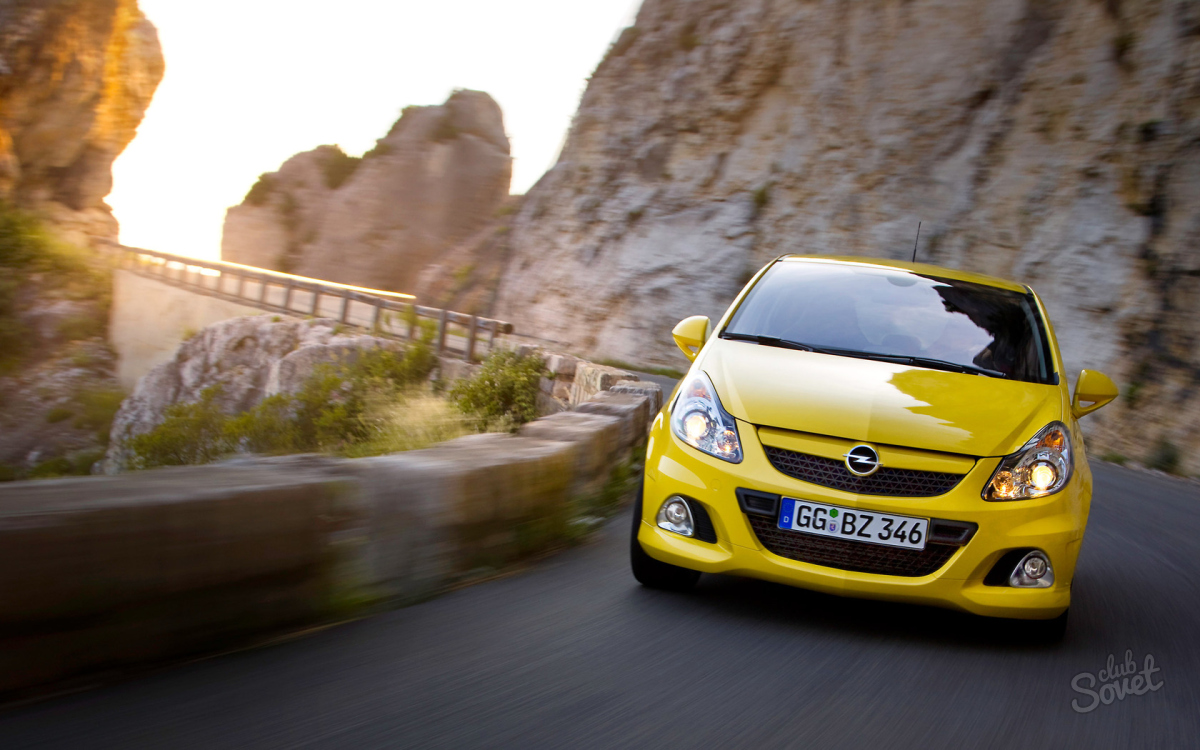

- entering the turn with the clutch depressed or in neutral gear;
- step / intermittent braking;
- sharp work with an accelerator (for rear-wheel drive cars this is fraught with a breakdown in a skid, cars with front-wheel drive tend to demolish the front axle from the trajectory);
- sharp turns of the steering wheel.
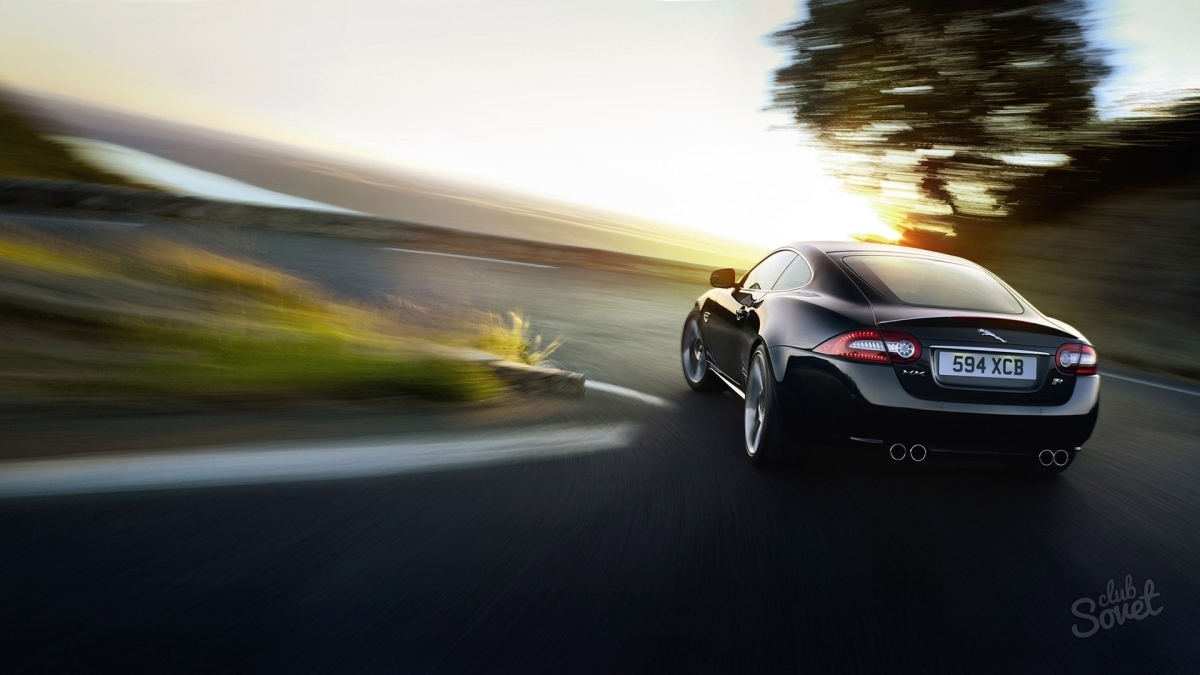
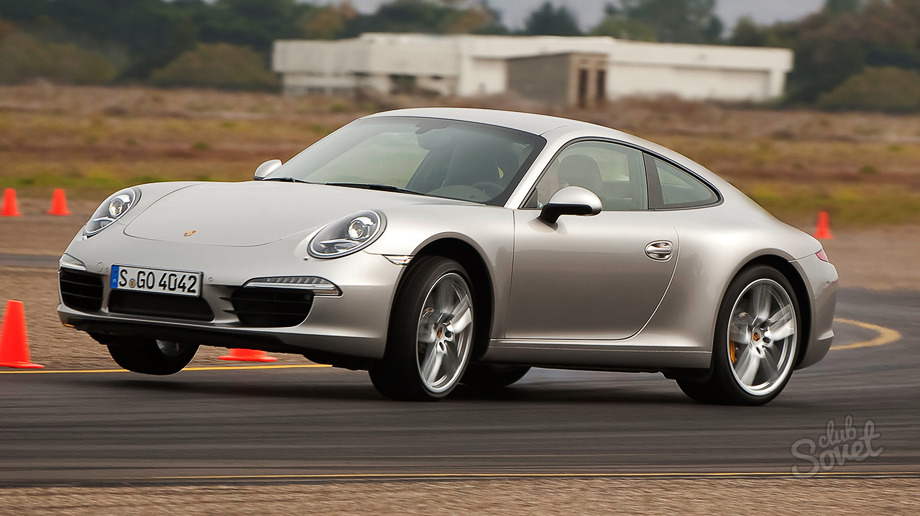
In general, cornering safety depends on the correct and timely assessment of the road situation, the ability to predict the behavior of the car based on its characteristics, and, of course, practice, including contra-driving techniques.
Turning left is clearly more difficult than turning right, since in this case it is necessary to control vehicles approaching the intersection from all four sides. Let's immediately begin to lay out the trajectory in three stages.
First stage
The first step in preparing for the left turn is to choose leftmost position. And already at this stage there are some difficulties.
When the road has a lane marking, as well as a line dividing the oncoming flows, it is enough just to snuggle up close to the “center” line, and this will be the leftmost position (Fig. 12).
Fig. 12. The leftmost position in the presence of road markings
And if there is no road marking? For example, the road has just been covered with fresh asphalt and have not yet had time to mark the road.
In this case, it is necessary to "open your eyes wider", mentally divide the road into two equal halves and take a position that will clearly show all other drivers your intentions (Fig. 13). If at this time your left turn indicators are also included in your car, then everyone will understand what you are going to do in the future.
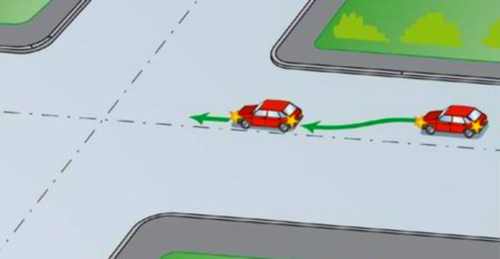
Fig. 13. Leftmost position on the bare road
Second phase
Turning path left through the imaginary center of the intersection provides not only the safety of maneuver, but also fully meets the requirements of traffic rules.
If the turn is through the center of the intersection, it turns out that you are constantly on his the right side of the road, both before the start of the turn and after it (Fig. 14).
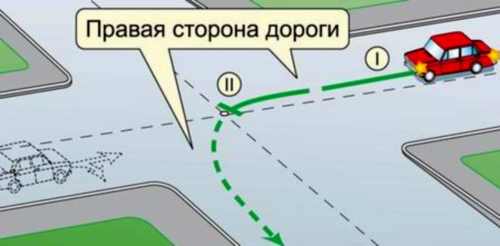
Fig. 14. Center of the intersection as an element of the left turn trajectory
Approaching the center of the intersection, you need to finally establish yourself in the correctness of the choice of the trajectory of movement relative to this center. And the trajectory depends on ... the direction of movement of oncoming cars!
If oncoming traffic moves directly or to the right, then this in no way affects the trajectory of your car (Fig. 15). You have only to give way to oncoming cars, for which you can simply reduce the speed or completely stop near the imaginary center of the intersection. But in any case, the trajectory shown in Figure 14 should be maintained.

Fig. 15. Where to "give way"?
And if the oncoming car also wants to turn left? Unfortunately, the situation with a simultaneous turn to the left (and a turn) in traffic rules is not considered at all. Therefore, on the road, drivers are usually guided by an unwritten rule: "When turning left - leave the center of the intersection between the sides of the cars."
At large intersections this is usually the starboard side (Fig. 16), and at small intersections it is the left side (Fig. 17).
It turns out that the center of the intersection is the point that allows the driver to choose a safe left trajectory at any intersection.
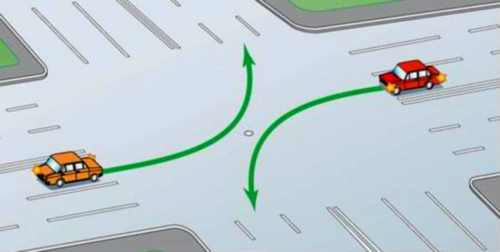
Fig. 16. Simultaneous left turn at large intersections
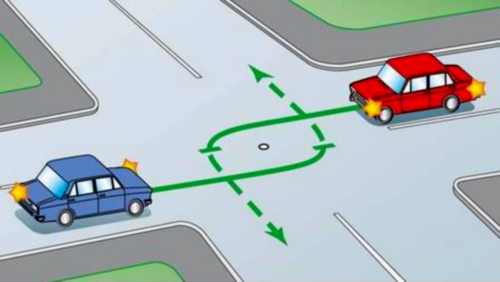
Fig. 17. Turn left at small intersections at the same time
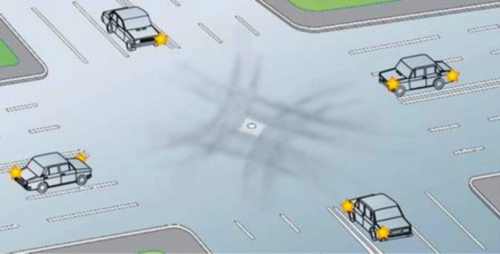
Fig. 18. Center of the big intersection
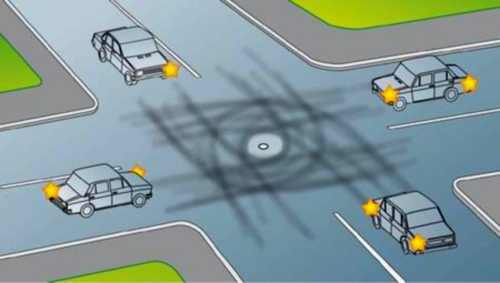
Fig. 19. Center of a small intersection
And how to find this "center" at a real intersection? After all, no "oily blot" will be drawn on the pavement!
Believe me, finding a center is easy. In summer, on dry asphalt, the center of the intersection is clearly visible in the form of a light gray “pillow” of a specific shape (Figs. 18 and 19). Since the wheels of cars at the corners are “drawn” with black rubber on asphalt, the pristine center with its shape will also tell you which side at this intersection it is customary to go around.
In winter, the center of the intersection is even better visible than in summer, there is pristine snow, a little cleaner than around. During rain, the center of the intersection is also clearly visible - it shines.
Figure 18 shows the center of a large intersection where, while turning left, the drivers of oncoming cars do not reach to the center.
At small intersections when drivers are moving center, another “cushion” is formed, similar in shape to a regular circle (Fig. 19).
Turn left through the imaginary center of the intersection to ensure maneuver safety.
So, we found the center of the intersection, figured out which side we will go around it, lost to oncoming transport if necessary, and then what? Then you need to leave the intersection.
Third stage
And again, getting out of the turn is more difficult than when turning right.
Approaching the intersection, it is advisable to plan all three stages of the turn. But, as you just learned, depending on the situation in a particular case, it is possible to adjust the trajectory near the center of the intersection. The choice of the trajectory of movement at the exit of the turn also depends on the specific conditions.
If the road that you are turning in has no more than two lanes in this direction, then getting out of the turn consists only in choosing a smooth trajectory ending in one of these lanes (Figs. 20 and 21).
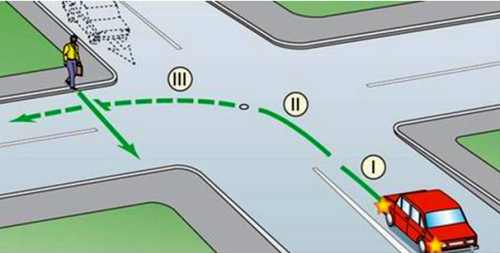
Fig. 20. One lane

Fig. 21. Two lanes
Another thing is if the road has three or more lanes in this direction. In this case, before reaching the center of the intersection, you should preselect Your personal lane and direct your car along a smooth trajectory understandable to other drivers to this lane (Fig. 22).
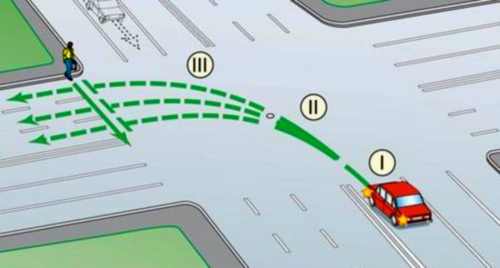
Fig. 22. Turn left onto a three-lane road
Exit the intersection when turning left allowed on any lane of the road that you are turning on, but you must not forget that the traffic on the far left lane has a number of restrictions (see section 9.4 of the SDA).
The right choice of lane, even before you go on it, is very important. An error with the choice of a lane leads to subsequent forced rearrangements, which does not give pleasure to either "newcomers" or "old men".
Unfortunately, in the statistics of road accidents there is one unofficial expression: "When turning left, the driver cut a corner" (Fig. 23).
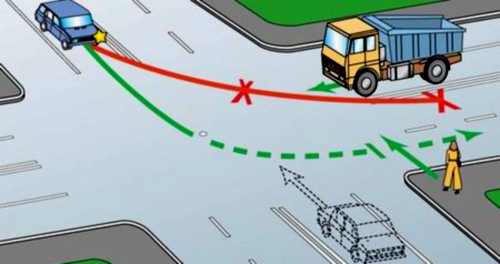
Fig. 23. The driver "cut" the corner
Some drivers, for reasons that are understandable only to them, do not reach the center of the intersection, "cutting off" most of the way in almost a straight line. Moreover, the probability of completing a turn is reduced by exactly 50%.
If today other drivers managed to see such a “shustrik” and dodged it, then tomorrow the driver of a truck will be too lazy to apply the brake and he will “educate” the offender (Fig. 23).
This was an example of a conscious violation of traffic rules, but there are other drivers who are not quite aware of what they are doing.
What is shown in Figure 24 in red is not invented, it can be seen on a real road!

Fig. 24. The classic mistake "beginner"
Such "miracles" occur when the "newcomer" in the movement tries to "wait" for the oncoming car. Instead of calmly stopping at the center of the intersection and waiting for oncoming traffic there, an inexperienced driver, without realizing it, continues to "crawl" further past the center of the intersection. And then (you can laugh or cry) makes such a "pretzel" that not every professional can repeat them.
The conclusion will be very simple - the trajectory chosen in accordance with the traffic rules and logic must be kept throughout the maneuver, regardless of possible stops on the way.
Deviation from the trajectory determined by the specifics of a particular place on the road is one of the first signs of an impending accident.
Especially if the road is slippery or snowy. Moreover, we will analyze this issue from a practical point of view.
We work with the wheel
What do you think is most important when cornering? Driving instructors They say that this is work with the steering wheel. You need to learn how to turn the steering wheel only once to the desired angle, and this should be done at the very beginning of the turn. And then it remains only to return the steering wheel to its original position.
When turning, the car obediently drives along an arc with an increase in gas (especially for rear-wheel drive cars), and the steering wheel is used to easily adjust movement, which does not lead to a change in the trajectory of the car. Learning such manipulations requires experience and time. Just train every day, calmly, without acceleration, without interfering with other participants in the movement.
Gently rotate the steering wheel along the ideal path to the minimum angle, and then also smoothly return it back.
Is drive type important?
Do not forget that the type of drive also affects cornering:
- Four-wheel drive . In this case, there is a neutral understeer, which allows you to pass the turn faster, but it requires special attention. Gliding the machine begins a little later, but the possibilities for corrective actions are very limited.
- Front-wheel drive. There is insufficient understeer, that is, a certain desire of the machine to “push” the turned front wheels out of the turn. With front-wheel drive, turn the steering wheel when cornering is needed earlier. This is especially true for slippery roads.
- Rear drive. With such a car, there is a tendency to oversteer or a tendency to skid the rear axle. You need to turn the steering wheel as gently as possible, and it is better to go through the turn with traction on the driving wheels.
Always be ready
If you still failed to stay in the corner, the main thing is calm and endurance. Tipping of the car can begin after hitting right or left wheels on obstacles during skidding, during rotation or when the car slides into the ditch. In such cases, it is extremely important to be able to quickly drive.
To stabilize the car, it is necessary to stop braking (if it was originally), and then turn the steering wheel toward tipping as soon as possible. You will have to apply quite a lot of force to the steering wheel, given the fact that the front wheel has a large load in the direction of tipping. A quick driver response will help prevent the car from tipping over.
If you need to "leave" the road, which runs along a high embankment and at an acute angle, then we recommend turning the wheels "in the field." Such a maneuver will reduce the likelihood of a coup.
If the rear wheels overtake the front wheels, that is, the car spins more than 90 °, remember the golden rule of the race drivers: Turns - Press both pedals to the floor. This means that both the clutch and the brake must be pressed simultaneously. As for automatic transmission, here translate the selector to neutral, that is, N. The car will stop much faster and more likely will not fly off into the ditch. And the engine will not stall, so you can quickly clear the road.
If the skid angle is less than 90 °, and the wheels are fully turned towards the skid, then only press the clutch pedal. So you get another chance to "catch" the car.
Video about safe cornering on a winter road:
Be polite and confident while driving!
The article uses an image from the site old.autodealer.ru


